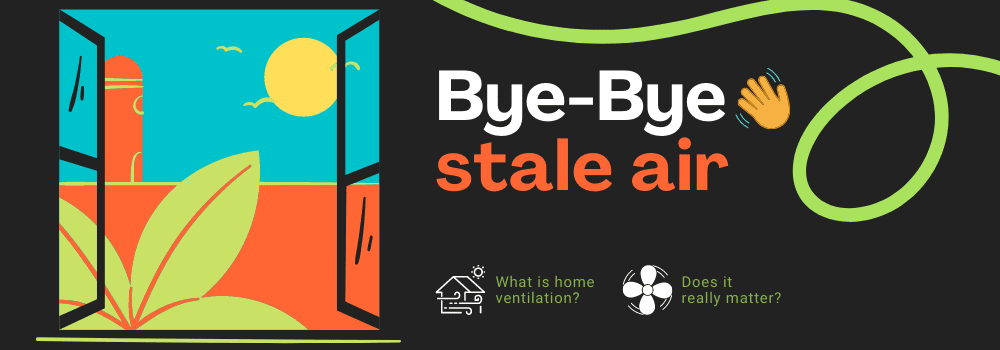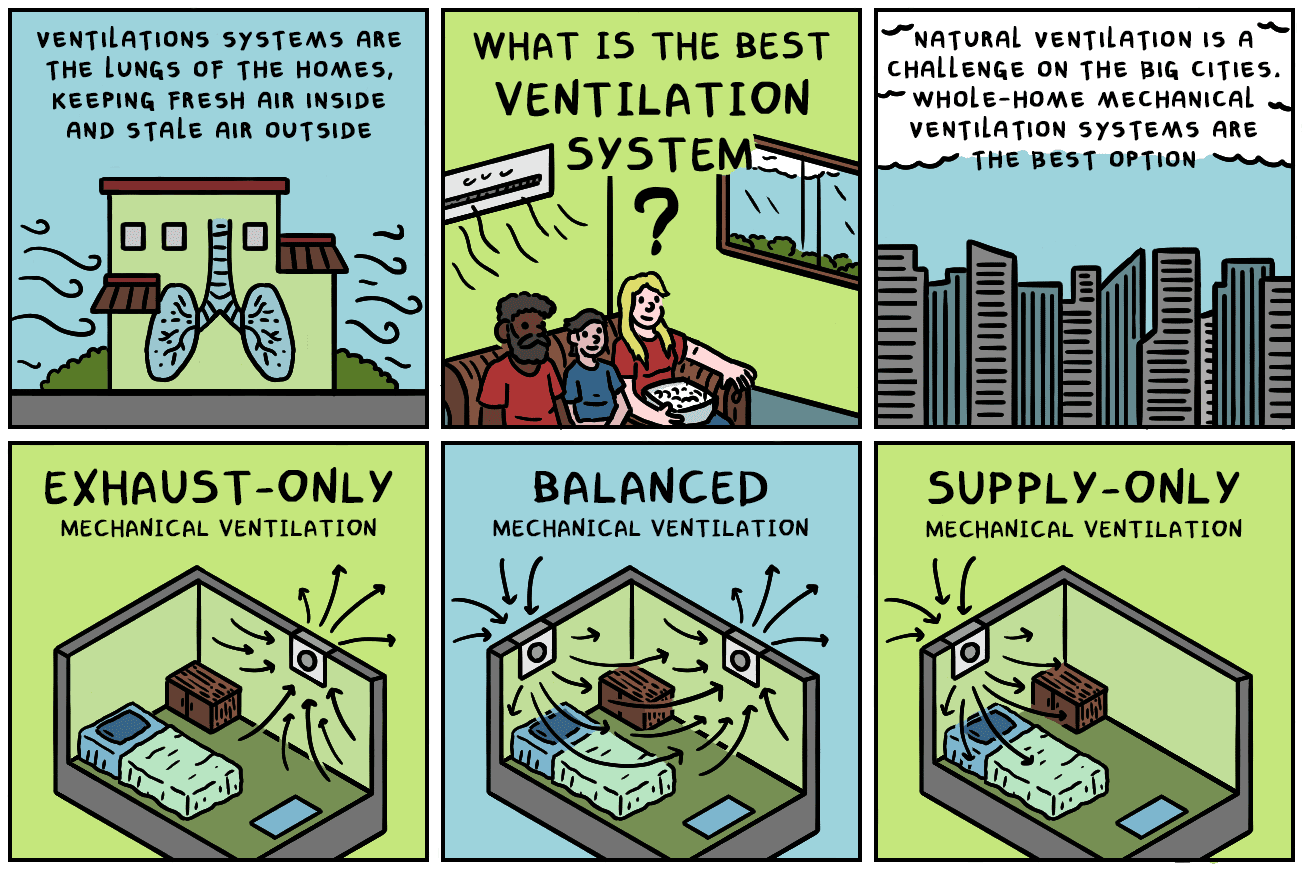Table of Contents
The Importance of Whole-House Fresh Air Ventilation
To live comfortably and achieve optimal health, people require fresh air. And yet, most of us are not consciously considering or monitoring our breath. Nevertheless, we breathe every minute of every day, each year that we are alive.
The thing is, fresh air isn’t always easy to get. Opening up the windows to let fresh air in isn’t always an option, especially when it’s cold or hot and humid outdoors. That’s why a mechanical home ventilation system is important.

Does A House Need Ventilation?
Short answer: absolutely! Ventilation is a necessary process for every indoor space. And it’s actually vital for your home’s quality, health and comfort—as well as the health and wellness of you, your family and all indoor occupants.
A home’s ventilation process is often referred to as the lungs. Which should make perfect sense. After all, we as humans exchange air in order to live. We breathe in oxygen and breathe out carbon dioxide. While ventilation is not as life-or-death for a building … At the same time, it sort of is. Especially when you consider that the health of everyone in that indoor space depends on it.
The bottom line: every indoor space must exhaust the polluted indoor air that has built up over time, and replace it with an influx of new fresh air. This is the home ventilation process. In essence, it is the simple exchange of indoor and outdoor air.
 Sick Building Syndrome and Indoor Air Quality: Learn the signs of sick building syndrome, and the IAQ solutions available to ensure your building or indoor space is a healthy one.
Sick Building Syndrome and Indoor Air Quality: Learn the signs of sick building syndrome, and the IAQ solutions available to ensure your building or indoor space is a healthy one.
Read more →
The Dangers of Unventilated Air
One of the biggest problems with unventilated spaces is the build up of stale air. Stale indoor air is not only unpleasant and uncomfortable, it’s unhealthy. Why? Stale air is either poorly circulated air or air that’s not circulated at all in an indoor space. That means you’re stuck constantly breathing in old recirculated air. And unventilated air is polluted air. For that reason alone, you want to upgrade to a home system able to exchange your indoor air as often as possible.
Plus, indoor air pollution is probably worse than you think. Indoor air pollution can originate from sources inside and outside the home. Indoor air pollutants include:
- Dust + Dust Mites
- Mold
- VOCs
- Pesticides
- Formaldehyde
- Wood Smoke
- Tobacco Smoke
- Carbon Monoxide
- Asbestos
- Pet Dander
- Bacteria and Viruses
- Nitrogen Oxide
What’s more, according to the Environmental Protection Agency (EPA), indoor pollution levels have increased in recent decades due to a lack of mechanical ventilation indoors. That’s primarily due to modern building methods and current building codes, which beneficial in many ways, actually make the home ventilation process harder. Therefore, reducing indoor air pollution requires intervention. It requires indoor air quality solutions.
Today’s building processes are focused on the goal of creating airtight buildings. The goal of airtight construction is to keep conditioned air indoors longer—whether warm or cool. This is an energy-efficiency perspective. It also results in less infiltration, or a lack of natural ventilation customary to older homes due to cracks, leaks and openings throughout the home’s structure. Air could seep in and out easily through these gaps. (Yes, an easier term is drafty.) Nevertheless, it makes ensuring proper home ventilation even more important.
![]() The History of Home Ventilation: But when exactly did airtight construction become the norm? How does the history of home ventilation and construction norms play into the need to ventilate your home? Let’s find out together →
The History of Home Ventilation: But when exactly did airtight construction become the norm? How does the history of home ventilation and construction norms play into the need to ventilate your home? Let’s find out together →
What Is a Whole-House Air Ventilation System?
A whole-house mechanical ventilation system is a fresh air solution for your home. The device installs directly into a central or forced air system. There, it works in tandem with your home’s ductwork and heating-cooling processes to provide fresh air to the entire space. This matters because fresh incoming air forces contaminated indoor air out. Dilution is the solution to pollution!
The main allure of a whole-home air ventilation system is that it provides fresh, filtered, air. Incoming fresh outdoor air is filtered during the intake process to remove pollutants, providing clean incoming air. All of this while simultaneously working to push stale, polluted indoor air out of the home. A true win-win.

Not all home ventilation systems are alike. Some are exhaust-only or supply-only, meaning they focus on one portion of the ventilation process. Instead, you want a balanced home ventilation system which both brings in fresh air and pushes out stale air. It quite literally balances the incoming and outgoing air.
 Balanced Mechanical Ventilation: Not only is mechanical ventilation separate from natural ventilation and spot ventilation, but there are different types of mechanical ventilation systems! It’s a lot … we get it. That's why we created a guide that explains the three ventilation processes and compares the three whole-home ventilation systems. Check out our guide →
Balanced Mechanical Ventilation: Not only is mechanical ventilation separate from natural ventilation and spot ventilation, but there are different types of mechanical ventilation systems! It’s a lot … we get it. That's why we created a guide that explains the three ventilation processes and compares the three whole-home ventilation systems. Check out our guide →
Energy Recovery Ventilation
Balanced mechanical ventilation systems are also energy recovery systems. Energy recovery mechanical ventilation reuses, or recovers, part of the energy otherwise wasted in the ventilation process. The system utilizes a heat exchanger which allows the device to transfer said energy. Inside the device, a series of fans and the heat exchanger makes the energy recovery process possible.
Why is this important? It means the whole-home solution can take energy from the outgoing already conditioned air and apply it to the incoming air. The system is actively making the most out of the outgoing conditioned air. And it does this both for cool air-conditioned air as well as warm, cozy heated air.
Find out which is best for your home →
Improve the Air Circulation Without Opening Windows
Yes, opening windows is the simplest ventilation method, but there are plenty of times when opening windows is not a viable solution. Every part of the country has a season or time of year where the weather makes natural ventilation not only impractical, but impossible. Whether due to freezing temperatures and snowstorms, extreme heat days or excessively muggy humid periods—climate is not a friend to natural ventilation. In addition to weather concerns, outdoor air quality is also a potential problem. There are times when the outdoor air quality is too poor and too polluted to serve as a helpful ventilation source—at least, unfiltered. Those living in cities, near high pollution sources like factories or simply on a busy road, your immediate surrounding environment makes natural ventilation more complex. For all of these reasons (and more!), natural ventilation is not the most reliable solution and certainly not an ideal long-term strategy.
Natural ventilation is also uncontrollable. It’s dependent on where in your home you open windows, how the air flows from room to room and various other factors. That’s why it’s great to have a system in place that improves air circulation without having to open windows. Upgrading to a whole-home mechanical ventilation system allows you to instead rely on your home system to collect fresh outdoor air, filter it and circulate it throughout your entire living space.
Another benefit to mechanical ventilation? Not only does it improve air circulation, but it also helps protect indoor air quality against outdoor air pollution. Mechanical ventilation limits outdoor air’s impact in a way that natural ventilation simply can’t. That’s the power of filtering the incoming fresh outdoor air before it’s circulating through your home.
 How Polluted Outdoor Air Impacts Indoor Air Quality: What are common outdoor air pollutants and how do they impact indoor air quality? Get the facts here to learn how to improve compromised indoor air. Learn more about outdoor air →
How Polluted Outdoor Air Impacts Indoor Air Quality: What are common outdoor air pollutants and how do they impact indoor air quality? Get the facts here to learn how to improve compromised indoor air. Learn more about outdoor air →